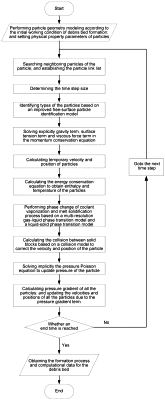| CPC G06F 17/11 (2013.01) | 10 Claims |

|
1. A method for analyzing debris bed formation based on a multi-resolution multiphase particle algorithm, comprising:
(S1) based on an initial working condition of debris bed formation in a nuclear reactor, performing geometry modeling to obtain a geometric distribution of particles;
(S2) performing a Link-list algorithm at each time step or several time steps to determine a position of each of the particles; and searching for neighboring particles within an effective radius of each particle's scope, and establishing link-list relationship for each particle;
(S3) according to the link-list relationship established in step (S2) and a Courant-Friedrichs-Lewy (CFL) condition, determining a time step size for a current calculation;
(S4) judging and identifying, based on an improved free-surface particle identification model, types of the particles in a computational domain, to identify an internal particle, a near-free surface particle, a free-surface particle, and an isolated particle in the computational domain;
(S5) solving explicitly a gravity and a viscous force for the internal particle, the near-free surface particle, the free-surface particle, and the isolated particle identified in step (S4); solving explicitly a surface tension for the free-surface particle; and summing accelerations caused by the gravity, the viscous force, and the surface tension to calculate a temporary particle acceleration;
(S6) according to the time step size determined in step (S3) and the temporary particle acceleration calculated in step (S5), calculating a temporary particle velocity and a temporary particle position;
(S7) according to the temporary particle position calculated in step (S6), solving a discretized energy conservation equation to calculate a particle enthalpy;
determining whether a particle undergoes a phase transition based on a change of the particle enthalpy; separating a gas particle from coolant particles undergoing a gas-liquid phase transition through a multi-resolution gas-liquid phase transition model; and correcting a phase state of molten particles that undergo a liquid-solid phase transition to become solidified through a liquid-solid phase transition model;
(S8) retrieving solidified particles to identify debris particles and debris bed; based on a solid-solid collision model, calculating collision among the debris particles and deformation of the debris bed; and in combination with the temporary particle velocity and the temporary particle position determined in step (S6), correcting velocities and positions of the particles;
(S9) based on the corrected velocities and the corrected positions obtained from step (S8), solving implicitly Pressure Poisson Equation (PPE) through a Biconjugate Gradient (BiCG) algorithm to update pressure of the particles; and
(S10) calculating a pressure gradient term of all the particles using updated pressure obtained from step (S9); substituting the pressure gradient term into a momentum conservation equation to update the velocities and positions of all the particles; outputting a calculation result at a current time step to generate real-time data of formation process, size, shape, and porosity of the debris bed for analysis of a debris bed formation process; generating and displaying a visual dynamic cloud map of debris distribution over time based on the real-time data of the formation process, size, shape, and porosity of the debris bed; and monitoring and locating for a user, conditions of the debris bed formation inside the nuclear reactor based on the visual dynamic cloud map.
|